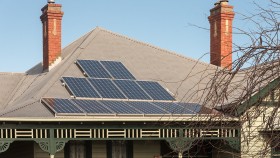Designing a house that absorbs carbon dioxide
To limit global warming to below 2oC, we must not only stop burning fossil fuels, we must also develop technologies that draw down atmospheric CO2 (an approach called ‘negative emissions’) and store it safely.
By 2050, over a billion new dwellings will be needed globally due to population increase, rural-to-urban shifts, and migration, mostly in the developing world.
Members of the Climate Change Institute have been working on a negative emissions house that draws down CO2 during its construction and is a net producer of energy in its operation.
“This research is really exciting because it provides an opportunity to solve lots of dilemmas at the same time with transformational effect”, said Dr Bec Colvin, Knowledge Exchange Specialist with CCI. “It’s a win-win project.”
“It helps tackle climate change, it turns a waste stream (CO₂) into a useful commodity, it transforms housing from being a major CO2 emitter to a CO2 sink and it helps provide relatively low cost housing for our growing population," said Dr Zonghou Yin of the Research School of Chemistry.
The research will also transform what people think a ‘house’ is through new designs, providing unprecedented flexibility. The cutting-edge NE photo-polymerisation-based 3D printing technology developed will help launch the world into a new era with a truly ‘green’ economy at its heart.
“It would allow everyone to actively address climate change in their daily life, by embedding an incredibly innovative technology into people’s homes,” continued Dr Colvin.
The project uses two key methodological innovations. It aims to convert CO2 to polymer-based building materials using sunlight-induced polymerisation. These polymers will be designed to be used in different roles within the house. Secondly, researchers are collaborating with industry to engineer the composition of new CO2-absorbing cements to be used in the foundations, increasing both CO2 uptake and structural strength.
ANU are well positioned for this type of research and we are currently seeking new funding streams.











